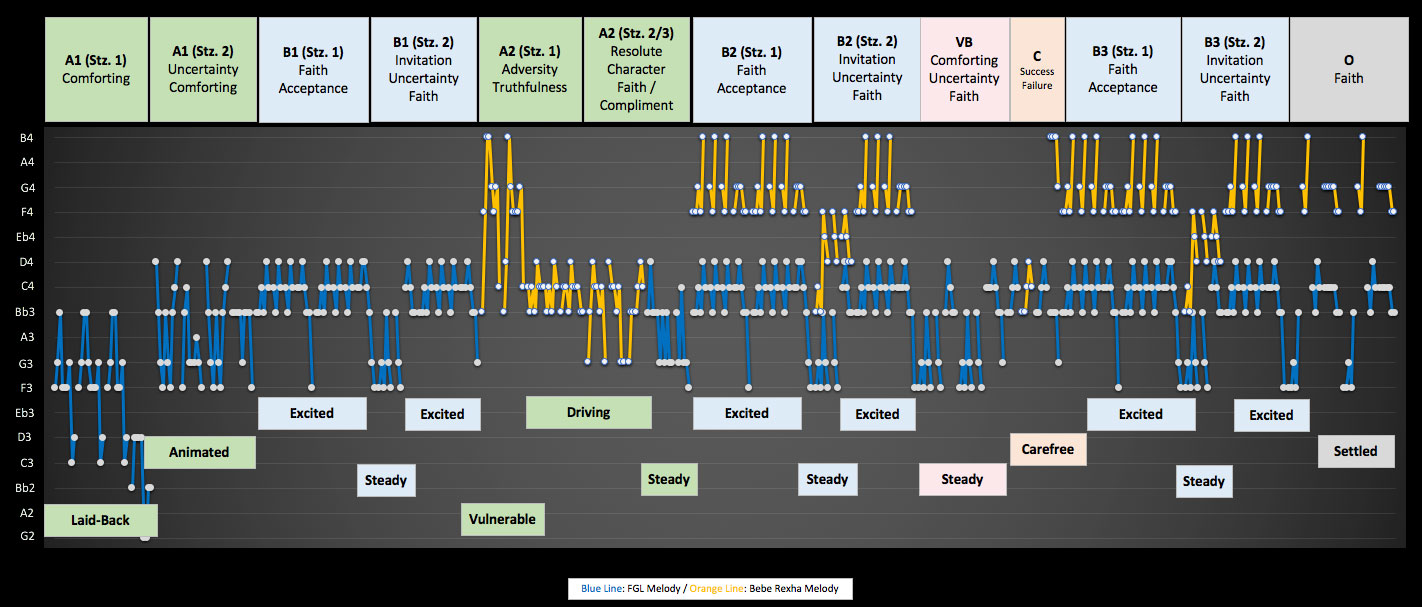Meant To Be is a collaboration between Pop artist Bebe Rexha and Country duo Florida Georgia Line. At just 2:41 in length, this record setting song (40 weeks at #1 on the Billboard Hot Country Songs chart and counting), packs in an abundance of hit songwriting qualities in a short amount of time.
Its meticulous blend of Country, Pop, Hip Hop and Trap influences enables the song to connect with an array of audiences. Its effective duet structure delivers the song’s inspirational message of faith in a highly engaging manner, and its abundance of repetition is balanced with just the right amount of contrast to get the song firmly ingrained in the listener’s head without becoming overly redundant.
Another one of Meant To Be’s core strengths is its prosody – the manner in which the music, vocals and lyrics work in tandem to create a compelling and engaging listening experience.
The chart below illustrates the essence of the narrative, vocal qualities and melodic patterns in each section of the song:
Top of Chart: Song sections and narrative summary | Left Side of Chart: Vocal melody pitches
Lines: Vocal melody direction | Dots: Vocal melody pitch indicators
Descriptions: Vocal delivery characteristics (laid-back, animated, excited, etc.)
Abbreviations: A=Verse, B=Chorus, C=Bridge, VB=Vocal Break, O=Outro, Stz: Stanza
*Click image to enlarge*
Intro
The intro is the sparsest section in the entire song, consisting solely of acoustic piano. Its timbre along with the chord progression welcomes the listener in with a warm, comforting, and laid-back vibe, which jibes with the overall essence of the narrative.
This comforting vibe is largely due to the use of something called a plagal cadence, which is the IV-I chord progression that’s heard at the end of each two-measure cycle throughout the song. This cadence is also referred to as the “Amen Cadence” because it’s commonly used at the end of religious hymns and provides a sense of comfort and resolve.
Verse 1
Verse 1 consists of two stanzas and is communicated by the protagonist, Florida Georgia Line (FGL). The first stanza possesses a live-in-the-moment, “relax and enjoy” premise, which is augmented by both the acoustic piano that carries over from the intro and FGL’s laidback delivery, which includes a relaxed slur at the end of lines 1, 2 and 3.
The second stanza shifts gears with the introduction of uncertainty into the lyrics. This is mirrored by FGL’s move to a higher register, the alternation of melodic descents and ascents, and the heightened rhythmic momentum compared the more carefree lines in the first stanza. However, the comforting line that directly follows is conveyed in a lower register and more settled manner, which brings the tension back down. The excitement ramps up once again on the ensuing line where the protagonist conveys his desire for the antagonist to be with him, and then returns to being more settled in the comforting line that follows, which is centered on the tonic and provides a sense of being home (harmonically speaking) as the section comes to a conclusion.
The effective balance of leaps, stepwise motion, and melodic direction shifts throughout the section keeps it feeling familiar yet a bit unpredictable, which is at the crux of the song’s narrative.
Verse 2
Verse 2 consists of three stanzas and is communicated both by the antagonist (Bebe Rexha – stanzas 1 & 2) and the protagonist (FGL – stanza 3). The first stanza (lines 1-4) finds the antagonist in a troubled emotional state where she details her past failed relationships. The first two lines, which depict her being “uptight” due to her “heart being hurt a couple times” are sung by Rexha and feature pronounced melodic leaps spanning an octave. These ascents to a high register effectively elicit a fragile, vulnerable quality that jibes the lyrics. Lines 3 & 4 that follow, which depict the “guys that didn’t treat her right,” are sung in a comparatively lower register with less melodic variation and heightened momentum, which jibes with this more downtrodden lyrical development.
The second stanza (lines 5-7) finds the antagonist becoming resolute in her desire to move on from her past negative relationship experiences and possibly establish something new and positive with the protagonist. The first two lines communicate her determination in an unyielding manner through the heightened momentum and pronounced melodic drops in Rexha’s delivery. However, she sings the last line in the stanza, “boy make me believe,” with a more settled and ascending melody, which jibes with the hope and faith that the protagonist might be the one. Note that this shift coupled with concluding on the second scale degree as opposed to the tonic leaves the door open for a response by the protagonist.
The third stanza (lines 8 & 9) provides an unexpected twist through the return of the protagonist (sung by FGL). He answers the antagonist with a statement of positivity through the acknowledgment of her beauty. Note that the stanza both begins on and is centered on the tonic, which provides a sense of stability and comfort, which helps to put the antagonist at ease. The accompaniment bolsters this development as well through its sparser and more serene qualities compared to the preceding stanzas.
Chorus
The chorus consists of two stanzas and is communicated by the protagonist (FGL) in chorus 1, and concurrently by the protagonist and antagonist (Rexha) in choruses 2 and 3. The first stanza (lines 1-4) features the repetition of the summation/payoff, “if it’s meant to be, it’ll be, it’ll be. Baby just let it be.” The first segment, “if it’s meant to be, it’ll be” is communicated in an excited, “roller coaster-type” manner that doesn’t resolve on the tonic, which delivers the song’s inspirational message of faith in a highly engaging and fervent manner. However, the statement that follows, “baby just let it be,” is conveyed in a more settled/steady manner and initially concludes on the tonic prior to the slur at the end. This effectively jibes with the acceptance connotation of the lyrics.
The second stanza (lines 5-8) begins with a development in the narrative through the invitation to journey into the unknown together. The lower register and more settled, direct delivery compared to the first stanza effectively jibes with and accentuates this development. The section then concludes in the same excited way as it began, albeit with changed up lyrics.
The manner in which the duet is structured has a narrative implication as well:
- Chorus 1 (follows verse 1): Verse 1 and chorus 1 are communicated by the protagonist to the antagonist. The chorus ties in with the relationship and uncertainty reflected in the first verse and pertains to the uncertainty that the “road in life” has in store.
- Chorus 2 (follows verse 2): Verse 2 and chorus 2 are communicated by both the protagonist and antagonist. They sing in tandem in chorus 2 (i.e. they harmonize) and share the same sentiment of uncertainty as it pertains to their relationship.
- Chorus 3 (follows the bridge): The bridge and chorus 3 are also communicated by both the protagonist and antagonist and reflect the potential success or failure of their relationship.
Furthermore, note that breakdown/clap and sing-along characteristic that defines the first stanza in chorus 3 provides the “if it’s meant to be, it’ll be” phrase with a more celebratory vibe.
Vocal Break (Post-Chorus)
The vocal break post-chorus, which follows chorus 2, is communicated most prominently by the protagonist (FGL). It reiterates the chorus summation with changed up arrangement and lyrics. The lyrics “so won’t you (ride with me”) have been changed to “so come on (ride with me).” The resulting heightened desire expressed by the protagonist is accentuated by the faster chord progression relative to its appearance in the chorus as well as the addition of tambourine and high-register nonsense background vocals.
Bridge
The bridge is communicated both by the protagonist and antagonist. Lyrically it provides a twist in the narrative by both characters conveying uncertainty regarding the potential outcome of their impending journey into the unknown together. Because they both accept whatever the outcome may be (i.e. “if it’s meant to be, it’ll be”, which they both convey in the second chorus), they alternate singing the potential positives and negatives with a settled, stepwise ascending melodic progression followed by a prolonged slur at the end. This invokes a carefree attitude that jibes with the crux of the narrative, “if it’s meant to be, it’ll be”: “maybe we do” (FGL), “maybe we don’t” (Rexha), “maybe we will” (primarily FGL with low-level harmony from Rexha).
However, a shift transpires on the last line where both the protagonist and antagonist harmonize in equal prominence conveying the potential negative outcome, “maybe we won’t.” Compared to the carefree deliveries that precede it, this line is sung in a mostly monotone manner with a pronounced melodic drop at the end, which provides the potential negative outcome with more gravity and impact. Note that this is the only point in the narrative where both characters express the same negative sentiment, and is the only time in the entire song where the protagonist expresses negativity (he’s been mainly positive up until this point).
Outro
The outro reiterates the last two lines from the chorus in a highly infectious and engaging manner through the phrase-to-phrase tradeoffs between the protagonist and antagonist. The partially thinned out/less intense accompaniment and more settled, relaxed, laid back deliveries compared to the preceding chorus elicit a vibe of faith-based acceptance between the two characters as the song comes to a conclusion.
Meant To Be’s strong prosody is just one of the many characteristics that helped it become a grand success. Be sure to check out the full Meant To Be Deconstructed Report for a deep dive into the songwriting and production techniques used to craft this song.
Hit Songs Deconstructed subscribers can log in here. Not a subscriber? Click here.

